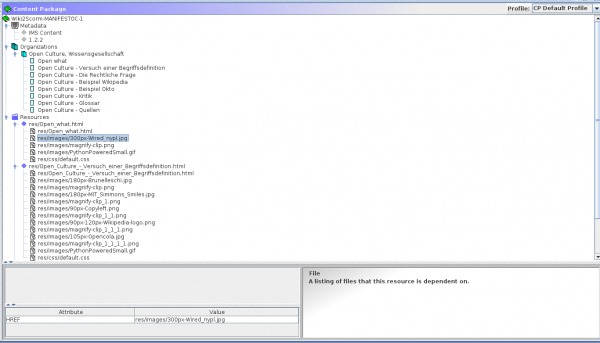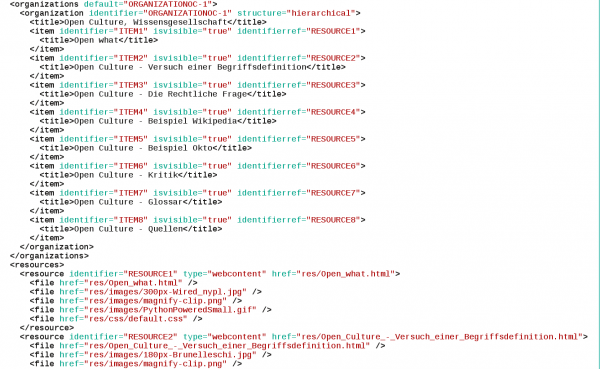MOOCs Resourcen (BD14)
Vorstufe: Lernobjekte
Entwicklungsgeschichte:
- Ein Projekt zur Gestaltung einer Lerneinheit (2007): Open_Culture (LWC).
- Ein Wikibook
- Lernplattform Ilias
- Online training Courses for your Business
Melissa Mallon, MOOC Report
Auszüge aus dem Public Services Quarterly, 9:46–53, 2013
Coursera (http://www.coursera.org) — includes over 200 courses with videos, quizzes, assignments, and opportunities to interact with fellow students. More than one million learners have participated in a Coursera course. The Pedagogy section of the site includes helpful explanations of online learning concepts, including peer assessment and mastery learning.
edX (http://www.edx.org) — free online courses from Massachusetts Institute of Technology (see more about MIT’s Open Courseware in the review below), Harvard University, University of California Berkeley, and the University of Texas System. After completing a course, participants receive a certificate from the “X University” from where the course originated. The open-source learning platform features learning spaces designed for the web, including wikis and online discussion boards.
Udacity (http://www.udacity.com) — a free “digital university” that offers beginner, intermediate, and advanced courses in computer science, statistics, and physics. Courses are completed at the user’s own pace, without assignments or deadlines and participants receive a certificate of completion after the course final.
Massive List of MOOC Resources
Visited: Fall 2012. Reviewer: Lisa Zilinski, Business Librarian, University of South Florida in Lakeland
The Massive List of MOOC Resources, Lit and Literati, created by Erica St. Angel, vice president of Marketing for Sonic Foundry and hosted on Mediasite, is a list of MOOC-related links composed as a blog post on The World of Webcast blog. ... this page is filled with a wealth of information regarding MOOCs. ... Since this page is no longer updated, additional resources will be required in the near future. ...
What You Need to Know About MOOCs http://chronicle.com/article/What-You-Need-to-Know-About/133475
Reviewer: Melissa Mallon, Coordinator of Library Instruction, Wichita State University Libraries
Published in The Chronicle of Higher Education’s Technology section, “What You Need to Know About MOOCs” is a virtual timeline of all things MOOC. The page covers the “what” and “why” of massively open online courses, as well as descriptions of the most commonly mentioned MOOCs. ... Most items on the timeline link to articles elsewhere in The Chronicle, which librarians can peruse to enhance their understanding of MOOCs and their place in higher education. ... One negative of this resource is that because it exclusively links to articles in The Chronicle, one must have a subscription in order to view the article’s full content.
Visited: Fall 2012 Reviewer: Emily Harrell, Online Librarian, American Public University System
Saylor.org, a source of massively open online courses (MOOCs), offers a free and open collection of college level courses through a 501C3, nonprofit organization established by M. J. Saylor, whose motto is “education should be free” (Saylor.org, 2012). Saylor.org currently offers 267 courses in the following areas: General Education, Art History, Biology, Business, Administration, Chemistry, Communications, Computer Science, Economics, English Literature, History, Mathematics, Mechanical Engineering, Political Science, Professional Development, and Psychology. The courses are self-paced and focus on undergraduate level studies. ...
Massachusetts Institute of Technology OpenCourseWare
Visited: Fall 2012 Reviewer: Sabrina L. McKethan, Assessment and Stacks Management Unit Supervisor, Willis Library, University of North Texas
The Massachusetts Institute of Technology (MIT) has partnered with major backers such as the Andrew W. Mellon Foundation, Dow, and Lockheed Martin to develop MIT OpenCourseWare (OCW). OCW currently offers 2,100 self-guided courses in a wide range of subject areas. All courses hosted on the site contain materials such as lectures, videos, assignments, and readings that are or have been presented in an MIT Classroom. ...
Visited: Fall 2012 Reviewer: Yvonne Mulhern, Instruction/Reference Librarian, Dick Smith Library, Tarleton State University
Udemy.com, created by Eren Bali, Oktay Caglar, and Gagan Biyan in 2010, allows anyone to take or create a class online. Udemy describes itself as a “crowd sourced learning platform” with “hundreds of great courses from world-class instructors.” There are more than 5,000 paid and unpaid classes offered by private companies, individuals, and institutions of higher education via open courseware pulled in from MIT, Stanford, and other prestigious universities. Categories range from Humanities to Education and Technology to Sports and Lifestyle. Most classes are free, and paid classes range in price from $1 to several hundred dollars. ... An Udemy account can be created by signing in with a Facebook username and password or by entering your email address and password.
Bernd Becker: MOOC und Bibliotheken
Auszüge aus: Behavioral & Social Sciences Librarian, 32:2, 135-138
In case you blinked and missed it, there is a new buzzword in education: “MOOCs.” These massively open online courses (MOOCs) can serve hundreds or thousands of students without the institutional hurdles found in classes at a university, such as acceptance requirements and physical location. Some schools are working with partners like Udacity and Coursera, while others schools are using home-grown websites or applications like iTunes U to deliver free instruction.
With this rapid growth in pedagogy come growing pains, and none are feeling MOOC pains more than bricks-and-mortar universities. As business interests in MOOCs increased, a group of educators met in Palo Alto, California, to draft the first MOOC Bill of Rights that aims to establish goals and boundaries within MOOC education (Kolowich 2013a). For libraries in particular, MOOCs raise the questions of how and where library services fit into the MOOC model.
The concept of MOOCs first emerged in 2008 when Stephen Downes and George Siemens took a chance to open the registration for their learning theory class to anyone with an Internet connection. The class quickly grew from 25 University of Manitoba students to 2,300+ students from all over the world (Parry 2010). Built on the theory of “open teaching,” the Downes–Siemens course has become a model for MOOCs, and has advanced the recognition of online education as an acceptable form of instruction.
In the context of changes that have occurred in online education, MOOCs are a natural evolution of services that were already in high demand. Apple’s iTunes U, for example, has been used as a repository for educational audio and video content since 2004. The service allows open access (via iTunes) to many prerecorded lectures and presentations from colleges, libraries, and museums. Just after its 3-year mark in 2007, iTunes U had reached 300 million downloads. By 2010, it grew to 700 million downloads. As of March 2013 iTunes U has surpassed 1 billion downloads, 60 percent of which originate from locations other than the United States (Owens 2013).
While iTunes U has created an electronic distribution model for educational content, MOOCs have evolved that model in that they are not tied to a specific software ecosystem (Apple devices are needed to utilize iTunes U features), and MOOCs are typically designed to foster connections between students (iTunes U has yet to incorporate a substantial messaging system like a class discussion board).
Several universities have already begun to experiment with MOOCs since the 2008 Downes–Siemens course. However, one of the major deviations from the original MOOC model is that many of the MOOCs in higher education are not as “open” as the Downes–Siemens course. As the New Media Consortium 2013 Horizon Report points out, “A key component of the original vision is that all course materials and the course itself were open source and free — with the door left open for a fee if a participant taking the course wanted university credit to be transcripted for the work” (11). In some of the more current MOOC experiments that universities are trying, there is usually a cost attached to the course. While the cost may be significantly less than traditional student fees, it compromises a course’s classification as being a pure MOOC. Semantics do not seem to be an issue, though, as evidenced in the popularity of universities using third-party services such as Udacity to administer variations of the MOOC model (at a cost) for both public and private institutions.
...
REFERENCES
Cassidy, M. 2013. Cassidy: Coursera class offers peek into determination of student body. The San Jose Mercury News, March 1. http://www.mercurynews.com.
Friedman, T. 2013. The professors’ big stage. The New York Times, March 5. http://www.nytimes.com.
Kolowich, S. 2013a. ‘Bill of Rights’ seeks to protect students’ interests as online learning rapidly expands. The Chronicle of Higher Education, January 23. http://www.chronicle.com.
Kolowich, S. 2013b. Georgia Tech, Coursera try to recover from MOOC stumble. The Chronicle of Higher Education, February 15. http://www.chronicle.com.
Kop, R., H. Fournier, and J. Mak. 2011. A pedagogy of abundance or a pedagogy to support human beings? Participant support on massive open online courses. International Review of Research In Open & Distance Learning 12 (7): 74–93.
New Media Consortium. 2013. NMC horizon report: 2013 Higher education edition. http://www.nmc.org/pdf/2013-horizon-report-HE.pdf. Owens, J. C. 2013. Apple’s iTunes U surpasses 1 billion downloads as online education takes off. The San Jose Mercury News, February 28. http://www.mercurynews.com.
Parry, P. 2010. Online, bigger classes may be better. The Chronicle of Higher Education, August 29. http://www.chronicle.com.

